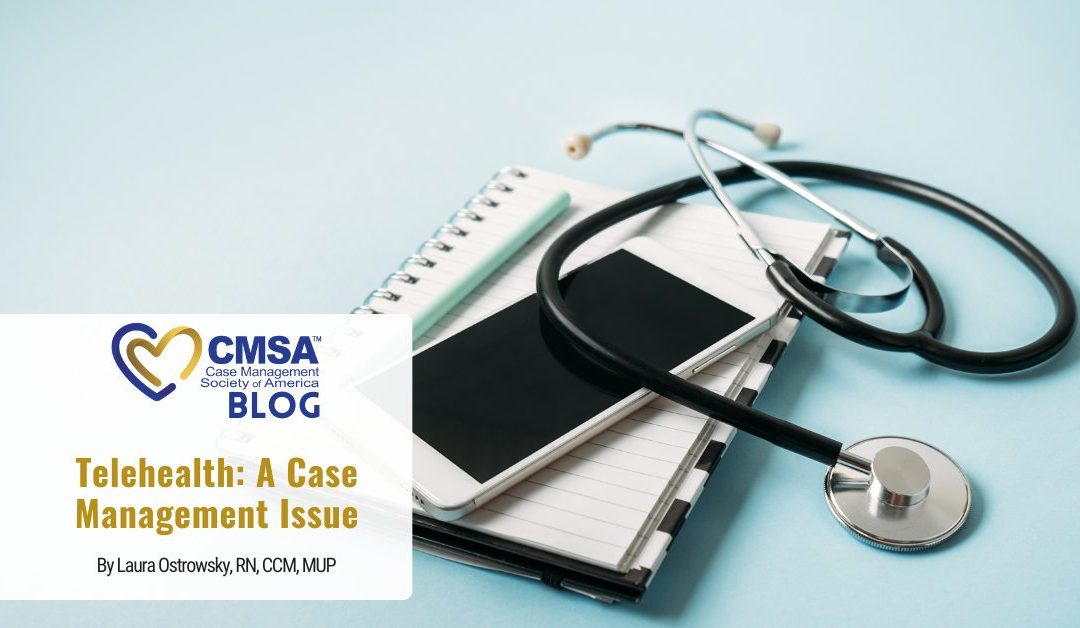By Laura Ostrowsky, RN, CCM, MUP
Telehealth is as old as people having phone conversations about their health with their doctors. It is about accessing care without an in-person visit to a provider. Of course, it has become more formalized and more comprehensive with the development of enhanced electronic communications via computers and cell phones providing more than just voice interactions. It has historically also utilized remote monitoring devices that can transfer clinical information such as vital signs about the patient to the provider. One early form of this was home monitoring to detect signs of preterm labor for high-risk pregnancies. This form of telehealth keeps people safely at home reserving scarce healthcare resources (inpatient hospital beds) for true acute care. Some payers and providers have worked together to create hospital-at-home programs.
Before the pandemic, we didn’t hear a lot about telehealth despite its obvious utility. This was in part because there were limitations in the ability to bill for services. One of the few positive outcomes of the pandemic was the spread of the use of telehealth. It became a necessity to increase access and decrease exposure and the ability to bill for it made more providers willing to implement telehealth in their practices.
In March 2021, 61.1% of Americans had completed a telehealth appointment, compared to just 19.5% a year before, according to a study by Sykes Enterprises.
From a public policy perspective, telehealth is a win. It provides increased access to care, it lowers costs, maintains continuity of care, enhances patient-provider communication, promotes adherence, and keeps patients engaged. Telehealth supports the case management process giving time for counseling, educating, and coaching patients.
The public policy implications for our patients are clear. We want to maintain and expand these opportunities. To that end, CMSA is calling for the strides that have been made through telehealth during the pandemic to be maintained and expanded. We are advocating for an expanded role for case managers in telehealth including reimbursement for these services where they are not already covered.
The Nurse Licensure Compact is a big part of this effort. Nationalizing the compact would allow nurses to provide services across state lines. Telephonic services often have multi-state geographic coverage. Let’s remove these barriers.
The CONNECT for Health Act of 2023 seeks to expand access to telehealth permanently, enhance oversight, and support healthcare providers and beneficiaries in utilizing telehealth. The pandemic relaxed requirements intelligently providing us with an opportunity to roll out programs expeditiously and we have seen positive results. Let’s not turn back the clock. Remember as case managers we want to be proactive, not reactive. It puts us at the forefront of positive change in healthcare.
We are change agents, role models, and advocates.
Issues under debate by stakeholders include long-term audio-only coverage; broadband connectivity; disparities in access to telehealth; appropriate payment for telehealth versus in-person care; concerns about fraud, quality, and safety; and the need for additional data to inform future policymaking. (nih.gov)
Telehealth hits all the case management buttons, improved access, lower costs, increased quality, patient engagement, and timely care. Put on your public policy hat and let’s get the process rolling, expanding, and working for all.
CMSA Members: Join us for the CMSA Virtual Hill Visits the week of March 4, 2024. Educate Congress and their staff about the importance of Case Managers, their role in improving patient outcomes, and CMSA’s three key legislative priorities: Telehealth, Mental Health and Workforce Development. Open and free of charge for all CMSA members. Register and make a difference at https://cmsapmg.wpenginepowered.com/hill-day/
Bio: Laura Ostrowsky, RN, CCM, MUP, spent 20 years from 1999-2019 as the Director of Case Management at Memorial Sloan-Kettering Cancer Center (MSKCC) and is currently teaching with the Case Management Institute and consulting on all things case management. Laura was the 2012 CMSA Case Manager of the Year. Her program at MSKCC was nominated by Case in Point for excellence in Utilization Management, Discharge Planning and Transitions in Care. She created a patient advocacy program to assist patients in obtaining access to specialty care despite network restrictions. The program has been featured in articles in Advance for Nursing, The Wall Street Journal, Case in Point, and Case Management Monthly. Laura holds a master’s degree in Health Planning and Policy from Hunter College. She has been a CMSA member since 2005, and has served on the Board of Directors of the NYC Chapter since 2011, and CMSA National from 2016-2018 and is a current board member of CMSA. Laura has over 30 years of health care experience, including time as a staff nurse, QA Coordinator, Director of UR and QA at Montefiore, followed by directorships in CM at New York Presbyterian(NYP) and Memorial Sloan Kettering Cancer Center. She also spent 3 years in information services at the NYP Network overseeing the selection, acquisition and implementation of an integrated hospital information application for UR, QA, Credentialing and Risk Management at 5 network hospitals. Laura has published articles on Case Management in CMSA Today, Professional Case Management, Case in Point, The Patient Flow Journal and other periodicals. She regularly presents at national conferences including CMSA, the Patient Advocate Institute and others on topics ranging from case management, patient flow and payer provider collaboration to advocacy, collaborative practice and case management’s role in the changing health care environment. She is also a past member of the Genentech speaker’s bureau where she presented on topics in oncology case management, palliative care and hospice.


Excellent Blog, Laura! It speaks highly to the benefits on the continued use and expansion of providing telehealth services across many levels of care!
I am once again signed up for our upcoming Virtual Hill Days in March. This will be a good resource of information in our sessions. Thx!